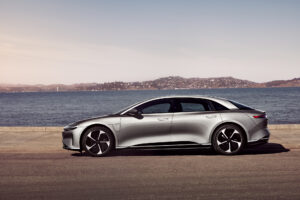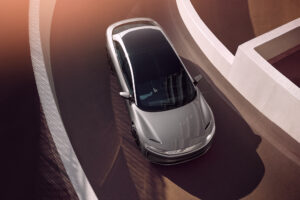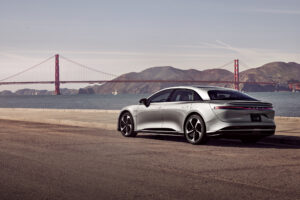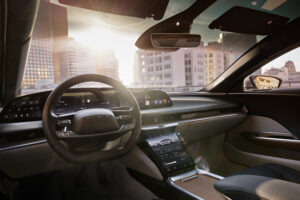

Peter Rawlinson and his team at Lucid really did their homework. Their first car ever, the Air, is handsomely designed and impressively engineered. They obviously know what they’re doing.
Let’s start with the styling. The Air debuted at the New York auto show in 2017. That means the design was finalized sometime in 2016. Yet, six years later, the car looks fresher and more modern than just about anything on the road today.
I would describe the look as clean, smooth and soft, the exact opposite of so many EVs with their busy details, hard edges and sharp creases. Inside, it’s inviting, comfortable and roomy. The instrumentation is business-like without being overwhelming, unlike the myriad of buttons and screens on the Mercedes EQS. And it avoids the austere minimalism of the Tesla Model S. The interior of the Air has a nice balance between the two. I like it.

Driving the car is what will convince most customers they want one. The door handles slide out as you approach the car, and it’s ready to go before you even get into the driver’s seat. No start/stop button needed to start it. Just buckle up, slide the shift lever to D, and you’re on your way.
It starts moving with some mechanical noise from the electric motors but is whisper quiet after that. And this car has gargantuan amounts of power that can accelerate you faster than you’ve ever gone in your life and probably a lot more than you’ll ever need. But that’s one of its selling points. It’ll spank just about anyone who dares to challenge you.

If you want to customize how the car drives, you can choose different drive modes on the center screen, including different suspension heights and regen settings.
Actually, that’s one thing I didn’t like, the regen settings. I prefer to use steering wheel paddles to set the regen mode, rather than going through a menu on the screen. Paddles are instantly available at your fingertips, while a menu means taking your eyes off the road and going through several steps. I’m one of those people who is constantly playing with the regen mode depending on the driving situation, so I want a quick way to change the settings.
As good as it is, the Air still needs some refinement in a couple of areas. While the fit and finish is generally good, it’s still not at the level of exactness that is demanded in the luxury class. At highway speeds I noticed more wind noise than I expected that seemed to be coming off the outside mirrors. The high level of “sticktion” of the steering wheel when using the adaptive cruise control and lane keeping was annoying. The AM radio reception was not good, making it hard to listen to a football game I wanted to hear. And the doors, which latch automatically, close with a bit of a rattle that is not right for a luxury car.

Lucid is aware of these issues and will fix them. One example: I took the Air to an automatic car wash but was unable to drive it onto the conveyor because I could not get the car into Neutral. Once alerted to the problem, Lucid sent an over the air update that fixed it. Ah, the miracle of modern technology.
The Lucid Air is a serious competitor in the EV luxury segment. Anyone shopping in the $90,000 to $150,000 price range should take a look at it. Yes, it has a few teething issues, but don’t let that dissuade you. Like fine wine, this car will only get better with age.
–John McElroy
Follow us on social media:

John McElroy is an influential thought leader in the automotive industry. He is a journalist, lecturer, commentator and entrepreneur. He created “Autoline Daily,” the first industry webcast of industry news and analysis.





